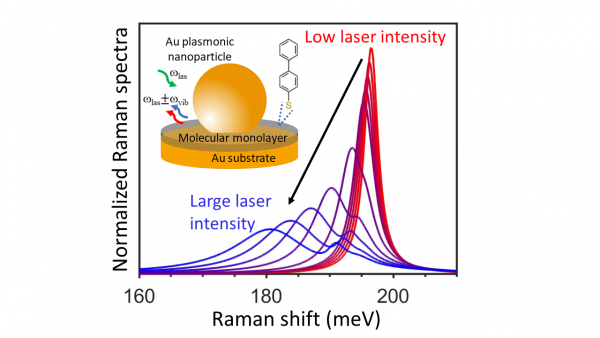Modifying the energy of collective molecular vibrations through optomechanical interaction

Figure : Evolution of the Raman spectra emitted by 100 molecules coupled to a plasmonic cavity as a function of laser intensity. The spectra are normalized by the laser intensity. The Raman shift in the x-axis corresponds to the difference of energy between incoming and scattered photons, so that the position of the maxima indicates the vibrational energy. The collective mode at lower Raman shifts exhibits a reduction of its energy of up to ≈20 meV, together with a strong increase of its effective losses indicated by the peak broadening. The inset shows a sketch of the system studied, with ωlas and ωvib the frequency of the excitation light and of the molecular vibrations, respectively.
Visible photons can interact with molecular vibrations of much smaller energies through an inelastic scattering process. The strong field confinement induced by plasmonic resonances in metallic nanocavities can activate an intense optomechanical interaction, producing large energy shifts of collective molecular vibrations.
The resonant oscillation of atoms in molecules at well-defined energies, results in a set of vibrational modes in the THz to mid-infrared spectrum specific to each molecule, and serve to fingerprint a molecule for selective detection and characterization. With this purpose, Raman spectroscopy exploits the optomechanical interaction between molecular vibrations (the mechanical modes) and optical photons in a cavity at visible and near-infrared frequencies. In this process, photons exchange energy with vibrations of much smaller energy, resulting in the emergence of photons of slightly shifted energy (Figure inset).
The Raman signal is usually very weak, but the efficiency of the optomechanical interaction can be strongly boosted by placing the molecules near metallic nanostructures that support resonant collective oscillations of the free electrons of the metal, the so-called plasmonic modes, which confine the optical energy to extremely small volumes. This technique is called Surface-Enhanced Raman Spectroscopy (SERS) and is widely used for molecular characterization and sensing. In the last decade, a cavity quantum electrodynamics description based on quantum optomechanics has been developed to describe SERS.
In this work, the team of the “Theory of Nanophotonics” group at CFM and DIPC, together with collaborators at Zhengzhou University, China, further developed the optomechanical description of SERS to calculate the Raman signal from many molecules situated in an extremely narrow gap, taking into account the full plasmonic response and plasmon-mediated vibration-vibration interactions. The results show that different collective vibrational modes are activated, and each of them experiences a different optomechanically-induced change of its energy and effective losses. These changes can be detected by a modification of the shape of the individual peaks in the Raman spectra, which split from a single Lorentzian spectral feature at weak laser intensities into two peaks of different energy and width as the laser intensity is increased (Figure). Further, this prediction is supported by experimental measurements by collaborators in Cambridge University, United Kingdom. These results thus indicate that collective vibrational properties of molecules can be modified through an enhanced optomechanical interaction in plasmonic nanocavities.



